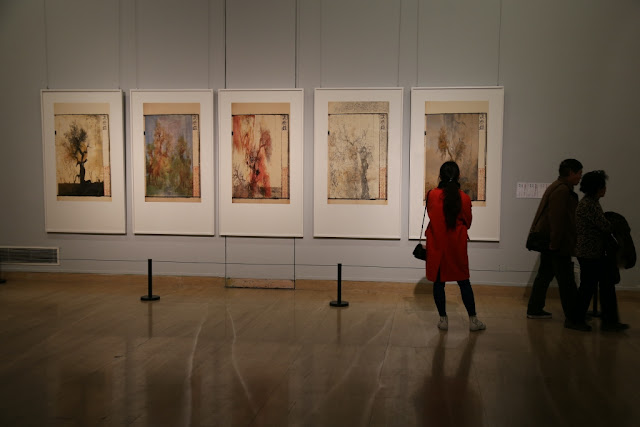“Harmony in Diversity” features 57 works by Chinese contemporary artist Fu Wenjun, including the unique “digital painting photography” style he developed through experimentation. The exhibition runs until 19 March 2017 at the National Art Museum of China in Beijing. This article was first published on Art Radar (15 March 2017).
 |
| Fu Wenjun, "Harmony in Diversity", installation view at the National Art Museum of China, 2017. Image courtesy the artist. |
Curated by Peng Feng, a professor at Peking University School of Arts and curator of the Chinese Pavilion at the 54th Venice Biennale, the exhibition “Harmony in Diversity” at the National Art Museum of China showcases five series by Fu Wenjun. The abstract, poetic works combine photography, installation and oil painting, coming together as what is referred to “digital painting photography”. The exhibition is organised by the Chongqing Federation of Literary and Art Circles.
 |
| Fu Wenjun, Harmony in Diversity No. 1, 2016-17, digital painting photography. Image courtesy the artist. |
What is digital painting photography?
Fu Wenjun refers to this as a “new” style of photography, developed after years as a documentary photographer, which blurs the lines between photography and painting. In many ways this experimental style furthers the boundaries of the photographic medium, providing the artist with the freedom to use symbolism and “collect visual elements” to create new meanings.
 |
| Fu Wenjun, A Long Journey, 2014-15, digital painting photography. Image courtesy the artist. |
Having studied oil painting at Sichuan Fine Arts Institute in 1983, Fu uses the similar concept of multiple layering to create dense, subjective works with “academic characteristics”. He has said:
Conceptual photography is an independent and unique way of making painting. Its major difference from other forms of photography lies in its expression of the subjective mood of the artist, and the artist takes photography as the medium to raise [a] meaningful topic or theme and then brings forth even deeper thinking on it.
 |
| Fun Wenjun, Game No. 1, 2013, digital painting photography. Image courtesy the artist. |
A confluence of cultures
According to the exhibition press release, the artist focuses on themes such as "the relationship between different cultures in the age of globalisation; the heritage of traditional Chinese culture in a rapidly changing society; industrialisation and urbanisation in Chinese cities." This is explored, for example, by the visual coexistence – rather than blending – of elements from Chinese traditional paintings and Western classical sculptures.
 |
| Fu Wenjun, "Harmony in Diversity", installation view at the National Art Museum of China, 2017. Image courtesy the artist. |
The artist told China Daily that the idea of combining different elements, such as a Chinese landscape painting with a Western-style sculpture and ancient rice paper, stemmed from his global museum visits:
I think a lot about culture, history and stories behind them when I see antiques from across the world displayed in museums such as the British Museum and the Louvre.
 |
| Fu Wenjun, Thought Reading No. 1, 2009-11, digital painting photography. Image courtesy the artist. |
“Thought Reading” (2010) comprises images of the Dazu Rock Carvings in Chongqing, a UNESCO World Heritage site steeped in history. The conceptual series utilises and modifies religious iconography.
 |
| Fu Wenjun, Post-Industrial Era, 2015, photography installation. Image courtesy the artist. |
Post-Industrial Era is made up of five wheels showcasing photos and a video. The images are of Chongqing’s factories, taken in the early 2000s to “record economic and social changes in the city”.
 |
| Fu Wenjun, A Wind from Yesterday No. 1, 2016-17, digital painting photography. Image courtesy the artist. |
In “A Wind From Yesterday”, created for this exhibition, Fu overlays images of the poplar tree (huyang) – which are known to survive for centuries – with images of paper used in ancient books.
More about the artist
Fu Wenjun (b. 1955) graduated from the Sichuan Fine Arts Institute and has been practicing photography for nearly three decades. He lives and works in Chongqing. He has had notable solo exhibitions at the Today Art Museum (Beijing), the United Nations Headquarters (New York), and the Guangdong Museum of Art (Guangzhou). In addition, he has participated in shows at the 5th Guangzhou Triennial, NordArt, and the collateral exhibition of the 2013 Venice Biennale.
 |
| Fu Wenjun, "Harmony in Diversity", installation view at the National Art Museum of China, 2017. Image courtesy the artist. |
The artist has won several accolades, including the first prize at the International Biennial of Contemporary Art in Argentina and the Lorenzo il Magnifico award at the X Florence Biennale. His work is included in several international collections, such as the Today Art Museum, Tokyo Metropolitan Art Museum and Societe Nationale des Beaux Arts in France.
Comments
Post a Comment